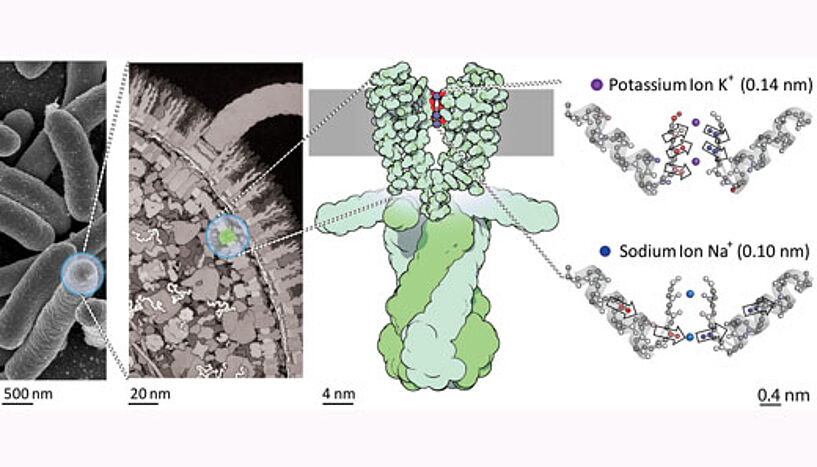Studying dynamics of ion channels
18. Mai 2015
Location of the potassium channel KcsA in the cell membrane of bacteria. The schematic illustration on the right shows the changes in strength and direction of vibrational coupling inside the filter depending on the ion species, as found by the study (Copyright: David S. Goodsell & RCSB Protein Data Bank).
New method to better understand the mechanism behind the extreme ion selectivity and transport properties in ion channels
Scientists from the Vaziri lab at the Vienna Biocenter (Austria), together with colleagues at the Institute for Biophysical Dynamics at the University of Chicago, have developed a method using infrared spectroscopy and atomistic modeling that would allow to better understand the mechanism behind the extreme ion selectivity and transport properties in ion channels. Their findings have recently been published in "The Journal of Physical Chemistry B".
Ion channels are essential structures of life. Ion channels are specialized pores in the cell membrane and move charged atoms known as ions in and out of cells, thereby controlling a wide variety of biological processes including brain function and heartbeat. Ion channels are generally selective for certain ions, allowing specific types of ions to flow through at very high rates, while hindering the flow of others. On the basis of this selective permeability, ion channels are classified as potassium channels, sodium channels, etc.
The cell’s most ubiquitous gateways are potassium ion channels – the importance of this type of ion channels was underpinned in 2003 when Roderick MacKinnon received the Nobel Prize in Chemistry for resolving the first atomic structure of the bacterial KcsA potassium channel.
Despite a large body of work, the exact molecular details underlying ion selectivity and transport of the potassium channel remain unclear. "Since conventional methods, such as X-ray crystallography, capture only averaged frozen structures, it is not possible to investigate how the dynamic of the protein could be involved in key aspects of their function", explains physicist Alipasha Vaziri, a joint group leader at the Max F. Perutz Laboratories (MFPL) and the Institute of Molecular Pathology (IMP) and head of the research platform "Quantum Phenomena & Nanoscale Biological Systems" (QuNaBioS) of the University of Vienna.
New method to unravel the secret of ion channel selectivity
Vaziri’s team, together with researchers at the Institute for Biophysical Dynamics (University of Chicago), have now used infrared (IR) spectroscopy coupled with molecular dynamic-based simulations of the obtained spectra to investigate the subtlest changes in the shape of the KcsA potassium channel that are induced by binding either potassium or the only 0.04 nanometers smaller sodium ion. This combination proved to be a powerful tool to disentangle convoluted IR spectra – which contain contributions from the whole protein – by assigning each part of the spectrum to the amino acids that contribute to it.
"This new approach allows us to probe these mechanisms in a non perturbative way, meaning without tedious and expensive isotope labeling strategies. Moreover, it opens the way to study the structure and dynamics of ion channels on their biologically relevant timescales by extending it to two-dimensional infrared spectroscopy", says Christoph Götz, PhD student in the Vaziri lab and co-author of the paper.
The study shows for the first time that the combination of the two methods can be used to detect subtle conformational changes in large membrane proteins, such as the KcsA potassium channel. Furthermore, it opens the way to capture the dynamics of proteins in real time at atomic resolution, which has been impossible with standard techniques until now.
Publication in "The Journal of Physical Chemistry B":
Paul Stevenson, Christoph Götz, Carlos R. Baiz, Jasper Akerboom, Andrei Tokmakoff and Alipasha Vaziri: Visualizing KcsA Conformational Changes upon Ion Binding by Infrared Spectroscopy and Atomistic Modeling. In: The Journal of Physical Chemistry B (April 2015).
DOI: http://dx.doi.org/10.1021/acs.jpcb.5b02223
Wissenschaftlicher Kontakt
Ass. Prof. Dr. Alipasha Vaziri
Max F. Perutz Laboratories (MFPL) and Research Platform Quantum Phenomena & Nanoscale Biological Systems (QuNaBioS)Universität Wien
+43-1-79730-35 40
+43-664-60277-542 52
alipasha.vaziri@univie.ac.at
Rückfragehinweis
Dr. Lilly Sommer
Max F. Perutz Laboratories, CommunicationsUniversität Wien
1030 - Wien, Dr.-Bohr-Gasse 9
+43-1-4277-240 14
lilly.sommer@univie.ac.at
Downloads:
20150518_Vaziri_JPhysChemB_figure_eng.jpg
Dateigröße: 1,94 MB
